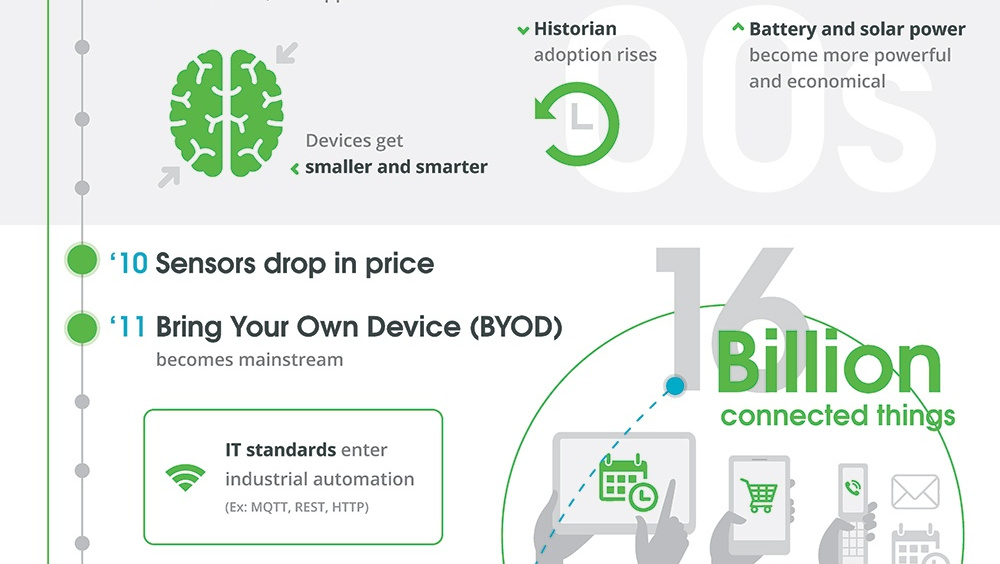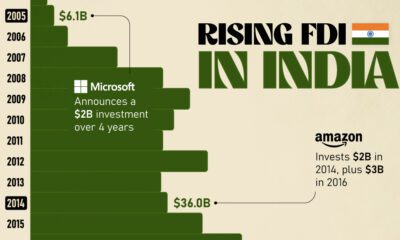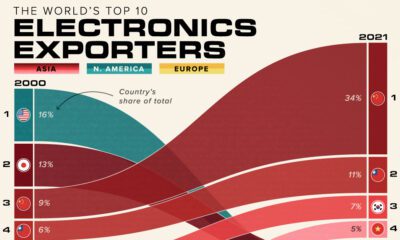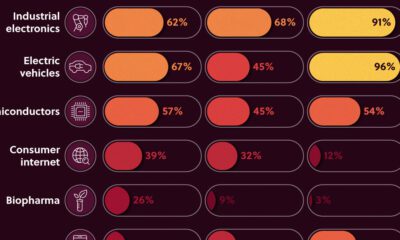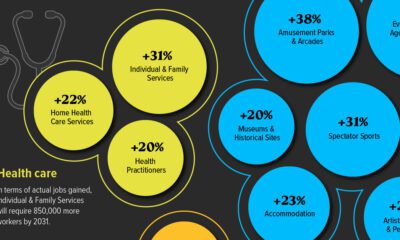Technology
Timeline: The History of the Industrial Internet of Things
The Internet of Things (IoT) isn’t only for connecting the latest gadgets, like a voice-activated speaker or a smart thermostat, to your increasingly connected home.
In fact, the same circumstances that have led to the explosion in smart consumer gadgets, such as universal wireless connectivity, cloud computing, cheap sensors, and better artificial intelligence, are also being used in conjunction with big data to power the next generation of industry, as well.
This new technological layer, called the Industrial Internet of Things (IIoT), is transforming massive industries like manufacturing, energy, mining, and transportation – and it’ll have a multi-trillion dollar impact on the economy as a whole.
The Birth of the Industrial Internet
Today’s infographic comes to us from Kepware, and it shows how these technological forces have emerged over time to make the IIoT possible.

The road to the creation of the IIoT started in 1968, when engineer Dick Morley made one of the most important breakthroughs in manufacturing history.
That year, Morley and a group of geek friends invented the programmable logic controller (PLC), which would eventually become irreplaceable in automating assembly lines and industrial robots in factories.
Other Major Innovations
Here are some other major innovations that were instrumental in making the IIoT possible:
1983: Ethernet is standardized
1989: Tim Berners-Lee creates Hypertext Transfer Protocol (HTTP)
1992: TCP/IP allows PLCs to have connectivity
2002: Amazon Web Services launches, and cloud computing starts to take hold
2006: OPC Unified Architecture (UA) enables secure communications between devices, data sources, and applications.
2006: Devices start getting smaller, and batteries and solar energy are becoming powerful and more economical.
2010: Sensors drop in price, enabling them to be put into pretty much everything
And today, the IIoT is a big deal: it’s transforming the backbone of major industries by adding a new layer of technology that helps companies optimize operations, track and analyze equipment, implement predictive maintenance, make sense of massive amounts of data, and make real-time decisions that were never before possible.
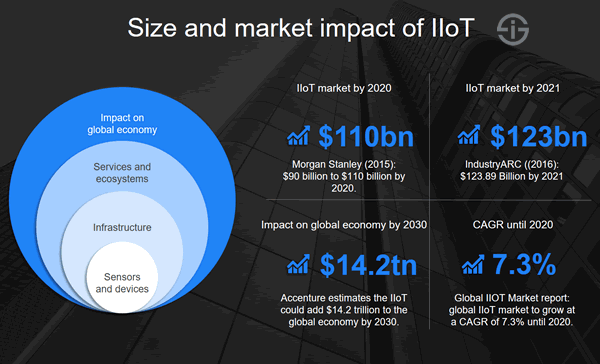
And by 2030, the IIoT is estimated by Accenture to have a $14.2 trillion on the global economy – making it one of the most important forces shaping the future business world today.
Technology
Visualizing AI Patents by Country
See which countries have been granted the most AI patents each year, from 2012 to 2022.

Visualizing AI Patents by Country
This was originally posted on our Voronoi app. Download the app for free on iOS or Android and discover incredible data-driven charts from a variety of trusted sources.
This infographic shows the number of AI-related patents granted each year from 2010 to 2022 (latest data available). These figures come from the Center for Security and Emerging Technology (CSET), accessed via Stanford University’s 2024 AI Index Report.
From this data, we can see that China first overtook the U.S. in 2013. Since then, the country has seen enormous growth in the number of AI patents granted each year.
| Year | China | EU and UK | U.S. | RoW | Global Total |
|---|---|---|---|---|---|
| 2010 | 307 | 137 | 984 | 571 | 1,999 |
| 2011 | 516 | 129 | 980 | 581 | 2,206 |
| 2012 | 926 | 112 | 950 | 660 | 2,648 |
| 2013 | 1,035 | 91 | 970 | 627 | 2,723 |
| 2014 | 1,278 | 97 | 1,078 | 667 | 3,120 |
| 2015 | 1,721 | 110 | 1,135 | 539 | 3,505 |
| 2016 | 1,621 | 128 | 1,298 | 714 | 3,761 |
| 2017 | 2,428 | 144 | 1,489 | 1,075 | 5,136 |
| 2018 | 4,741 | 155 | 1,674 | 1,574 | 8,144 |
| 2019 | 9,530 | 322 | 3,211 | 2,720 | 15,783 |
| 2020 | 13,071 | 406 | 5,441 | 4,455 | 23,373 |
| 2021 | 21,907 | 623 | 8,219 | 7,519 | 38,268 |
| 2022 | 35,315 | 1,173 | 12,077 | 13,699 | 62,264 |
In 2022, China was granted more patents than every other country combined.
While this suggests that the country is very active in researching the field of artificial intelligence, it doesn’t necessarily mean that China is the farthest in terms of capability.
Key Facts About AI Patents
According to CSET, AI patents relate to mathematical relationships and algorithms, which are considered abstract ideas under patent law. They can also have different meaning, depending on where they are filed.
In the U.S., AI patenting is concentrated amongst large companies including IBM, Microsoft, and Google. On the other hand, AI patenting in China is more distributed across government organizations, universities, and tech firms (e.g. Tencent).
In terms of focus area, China’s patents are typically related to computer vision, a field of AI that enables computers and systems to interpret visual data and inputs. Meanwhile America’s efforts are more evenly distributed across research fields.
Learn More About AI From Visual Capitalist
If you want to see more data visualizations on artificial intelligence, check out this graphic that shows which job departments will be impacted by AI the most.
-

 Markets1 week ago
Markets1 week agoU.S. Debt Interest Payments Reach $1 Trillion
-

 Business2 weeks ago
Business2 weeks agoCharted: Big Four Market Share by S&P 500 Audits
-

 Real Estate2 weeks ago
Real Estate2 weeks agoRanked: The Most Valuable Housing Markets in America
-

 Money2 weeks ago
Money2 weeks agoWhich States Have the Highest Minimum Wage in America?
-

 AI2 weeks ago
AI2 weeks agoRanked: Semiconductor Companies by Industry Revenue Share
-

 Markets2 weeks ago
Markets2 weeks agoRanked: The World’s Top Flight Routes, by Revenue
-

 Demographics2 weeks ago
Demographics2 weeks agoPopulation Projections: The World’s 6 Largest Countries in 2075
-

 Markets2 weeks ago
Markets2 weeks agoThe Top 10 States by Real GDP Growth in 2023

